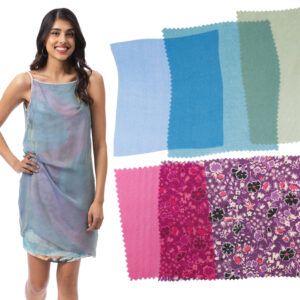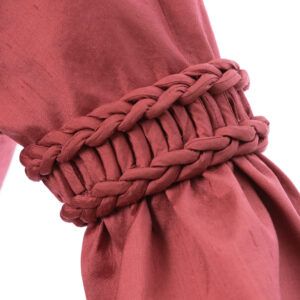Hi,
Just curious about what the main stitch was that people used before the sewing machine was invented. Was it a running stitch like people use when they hand piece a quilt? Or was it a back stitch? Mainly I am curious to know what the main stitch was for the main seam construction in a garment.
Thanks,
Sun
Conversational Threads
Threads Insider
Get instant access to hundreds of videos, tutorials, projects, and more.
Start Your Free TrialAlready an Insider? Log in
Conversational Threads
Highlights
-
Sign up for the Threads eletter
This site is protected by reCAPTCHA and the Google Privacy Policy and Terms of Service apply.See all newsletters -
 Sponsored Content
Sponsored Content
Where to Buy
-

-

-

-























Replies
MO - is it would depend on what was being sewn.
A back stitch would result in a "sturdier" join. Especially if clothing was being constructed.
A running stitch requires careful needle placement to avoid the needle being placed in the same point as the thread that is exiting.
The post should have some interesting responses.
me
I have two corset covers from my mother-in-law who was married in 1919, and every stitch in them is hand done. Back stitch, tiny, tiny back stitching. Not a running stitch in sight. I wasn't aware that the running stitch is used to hand-piece quilts. I always assumed (and used) the backstitch. Maybe you are thinking of the background quilting part though .So even if the sewing machine was in general use at that time, her wedding trouseau was done by hand.
Most hand-pieced quilts I've seen were sewed with a running stitch. (Maybe there were regional preferences?) A running stitch is much faster to do than a back-stitch, but it's also pretty weak and tends to come apart more easily, especially if only tied or lightly quilted.I'm amazed that in 1919 your grandmother hand-sewed her wedding clothes! The sewing machine was common by then and they had all the attachments to make sewing clothing quite easy. Annie in Wisconsin, USA
~~Doodlestein Designs Quilt Patterns
~~Finely Finished: Machine quilting worked on a treadle sewing machine.
See patterns, quilting, and National sewing machines at: http://community.webshots.com/user/damascusannie
Edited 1/19/2009 9:32 am by damascusannie
I rather doubt that my MIL's garments were sewn by her (she went to a private school where she learned serve a lady-like tea but was taught little else that was of use to her in her later life - in England). Most likely the work was done by the woman who came by the house several times a year to sew for the family who weren't well off but in the English tradition had to hold up their reputation as "genteel" members of the community!!All the other seams were tiny French seams. I wore them for nightgowns for a number of years until I realized what prizes I had.
That's interesting because here in the U.S. women did hire professional seamstresses, but they used sewing machines to do the work.
Your post made me curious. I have a traveling dress (2 pieces) that was made about 1880, so I had to go look. It was all hand sewn using a backstitch for the seams. What really caught my eye was how many 'couture' techniques that were used! All of the seams are fininshed with hand overcasting; the metal boning is catch stitched to the seams, hand beading on the edges of the jacket/blouse and collar. If I get a chance..and can find my camera...I'll try to take some photos and post them. It is my favorite piece, and I hope one day to make a duplicate....just for the heck of it.
Deb
I agree with everyone else--the backstitch for strength. The running stitch was mainly used for basting and temporary seams and adding embellishments, which would often be re-used.
In the late 19th century, my grandmother and her twin used to drape and stitch gowns for special occasions from a single length of fabric using a running stitch so that they could easily re-drape the fabric into different styles. But they made my grandfather's and mother's clothes using tiny back stitches.
My silk tea dress from the early 1900s has machine stitching for the foundation seams, but only hand stitching for anything that can be seen. The lace is attached with a line of French knots, the binding is catch-stitched, and the ruching is tacked with tiny stitches that don't show from the front. A corded, ruched band is attached with a running stitch over a machine-stitched edge at the hem, and a machine finished bias band is handstitched over the back of the elaborately embroidered border of the overskirt. I cannot imagine how many hours of hand-stitching went into this exquisite garment!
I love seeing the details of vintage clothing...both inside and out. Any chance you could take some pix of the dress and post them?
Deb
Will do! I have some glorious film-based prints of my DD wearing the dress and will try to find them and scan them for posting.
When the sun comes out again (Yay--California is finally getting some much-needed rain!) I can take some with our nifty new digital camera that has a macro setting for fine detail. My sister bought this exquisite gown for 50 cents at a garage sale; fortunately, it has only one tiny mothhole of damage so far!
According to Claire Shaeffer in Couture Sewing Techniques (I finally have her book, Yay) The running stitch is used for seams with little strength needed, the backstitch for everything that needed a strong, elastic stitch. That makes sense to me. Cathy
I got her book last fall. I don't know how I ever sewed without it. It has so much info...great for reviewing techniques I haven't used for a while. But even better for learning. I really had no one to show me fine sewing techniques, and have learned a lot on my own...most especially during the last yr. through Threads and Gatherings.
I love using couture techniques. I did a hand overcast finish on seams instead of doing it on the machine. I couldn't believe how much softer the finish was. I was really impressed with the difference.
Deb
I learned a lot of the stitches when I needed them in Tailoring. But I was never taught to use them elsewhere! I am quickly seeing where I can avoid problems, and go in and do things by hand I could not do by machine. Best of both worlds. So much in technique has been pushing fast, easy and machine techniques. I guess I just am not satisfied with them. I want better. So, hand finishing, hand sewing are going to be it. Slow and steady wins the race. I guess I collect turtle and tortoise stuff for a reason, tee hee. Cathy
This post is archived.